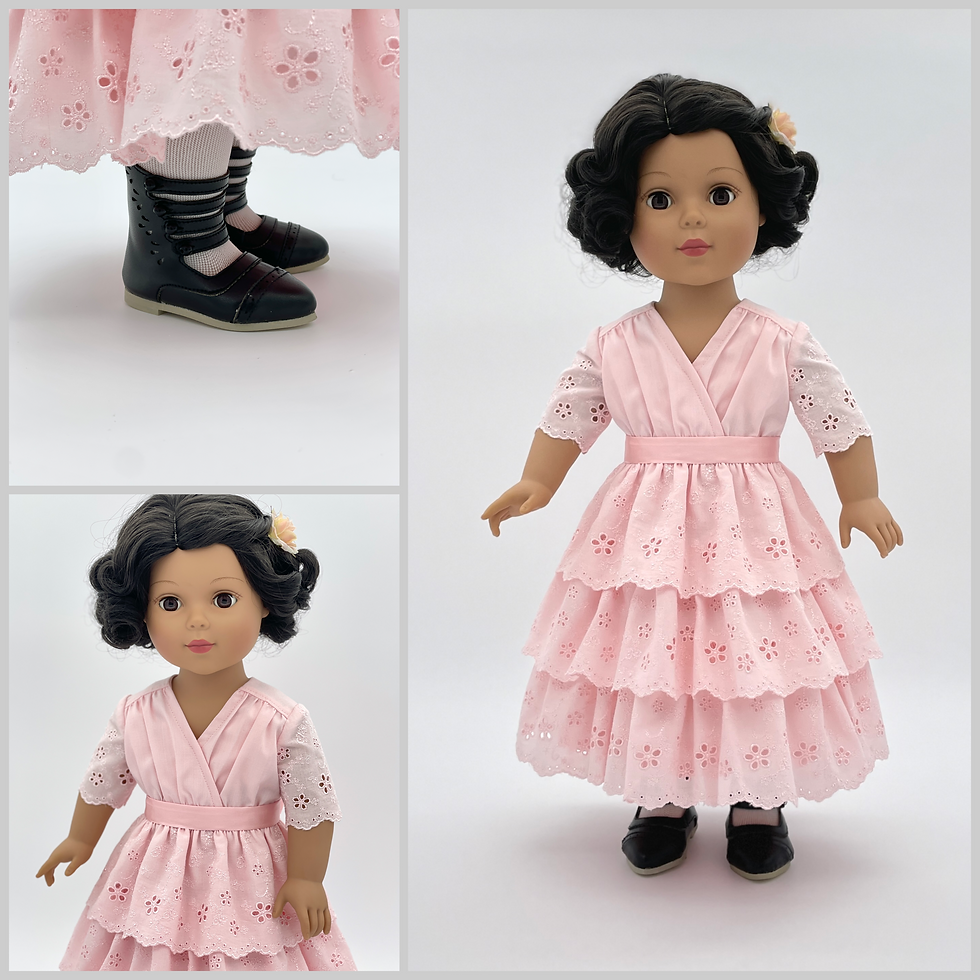An Edwardian Summer - Issue 2
- BbeautyDesigns

- Jul 22
- 5 min read
Updated: Jul 24
Presenting the 1910s Summer Collection by A Stitch in Time’s Line

Hello BBeauty readers! This is Ava Smith from A Stitch in Time’s Line. Today I am pleased to share a first look at my upcoming release of six historical ensembles, each featuring a pair of shoes or boots from BBeauty Dolls’ elegant Edwardian footwear collection. These outfits will be listed individually in my Etsy shop (astitchintimesline.etsy.com) at 7 PM EST on Saturday, July 26th. Whether or not you are interested in purchasing one, I hope you enjoy browsing this little catalog of summer styles! I’d like to begin my description of the following gowns with a confession.
Despite the title of this collaboration, none of my dresses are from the true Edwardian era. In its strictest sense, the “Edwardian era” refers to the period of King Edward VII’s reign in England from 1901 to 1910, although many historians extend the term to cover the years leading up to the outbreak of World War I in 1914. This is because the social and political characteristics associated with the Edwardian period persisted beyond Edward’s death and into the early years of George V’s reign. World War I however, caused significant and lasting changes in British life, effectively ending this era and ushering in a new one marked by rapid and turbulent social change. While I love the opulent, lace-covered, floor length gowns of the true Edwardian era, the transitional fashions that followed in the 1910s have fascinated me for years and I wanted to showcase them in this collection.
How did we get from the Gibson Girl to the 1920’s flapper in less than a decade? I hope we can explore those changes through this collection of dolly sized outfits representing this often overlooked little era of fashion.

The first outfit I have to share is an early 1910s girl’s dress made with Lemon Bay Doll’s new Pollyanna pattern. In the pattern introduction, Michelle says: “The design for the Lemon Bay Doll ‘Pollyanna’ dress was inspired by the costumes in Disney’s 1960 film Pollyanna starring Hayley Mills. The film is based on the 1913 novel of the same name by Eleanor H. Porter. As in the book, the film is set in 1912. This period is loosely known as very late Edwardian, but since the 1990s blockbuster Titanic (a fictionalized retelling of the ship’s sinking in 1912) , this brief pre-WWI period is now often referred to as 'The Titanic’ fashion era. It defines the elongated and slender fashion styles of the years 1912 to 1914.” While children’s fashion did not change as rapidly as women’s fashion during the 1910s, there was a similar, if more gradual shift towards comfort and simplicity. In 1912 the ornate Edwardian influence was still very prevalent, as seen in this dress made of pale-blue silk taffeta with delicate lace trim at the yoke, sleeve cuffs, and skirt hem. I have paired this frock with a pair of BBeauty’s white Edwardian Double Strap Shoes, which perfectly compliment without overwhelming the dress.
Much of the 1910s transition to a simpler silhouette in women’s fashion is attributed to the influence of WWI (1914 – 1918) which impacted all areas of life. Many women entered the workforce at this time and fashion was simplified to meet their needs. Skirts in the early 1910s were long and slim fitting, but in 1915 a trend suddenly emerged of fuller, calf-length skirts. War crinolines, as this style was dubbed, took the fashion world by storm despite initial criticism of their “improper” length. A favorite 1916 fashion slogan was: “The war is long, but skirts are short!” In 1917, however, the trend for full skirts faded away, along with hope for a quick end to the war.

My first published sewing pattern, the 1916 Summer Dress, reflects the optimism of this fleeting fashion trend, and I hope, captures the midpoint between Edwardian and 1920s fashion. This floral cotton lawn dress is a remake of one of the dresses featured on my pattern cover. Since this material is very lightweight, I designed an era appropriate princess slip to fluff out and add opacity to the skirt. Additional accessories for this ensemble include a pink silk parasol, a pair of BBeauty’s Edwardian Cut Out Boots in dusty rose, and a cream-colored straw hat trimmed with silk flowers.

I am also bringing back the popular version of this dress done in pink eyelet lace with a three-tiered ruffled skirt. This version of the 1916 Summer Dress skirt can be made with either fabric or lace ruffles. I have paired this frilly, feminine dress with the Edwardian Cut Out Boots in black, and a simple pink silk ribbon sash.

I had just enough of this extra wide eyelet lace in my stash to create a new version of the pink eyelet dress as well, featuring the simple skirt variation of my pattern. I chose white accessories to compliment this dress: a pair of white cut out boots, a silk ribbon sash, and an oversized hairbow appropriate for a child or young teenage girl from this era.

I used a sage green tissue taffeta silk, and the tucked skirt variation of my pattern for the final 1916 summer dress in this release. Since the silk is very light and somewhat sheer, this dress also has a princess slip, this time finished with a wide eyelet lace ruffle. I decided to go all out with the accessories for this gown! The large, flower and feather trimmed hat and elegant parasol are made from white silk (to match the white cut out boots) with mauve accents to match the silk ribbon sash.

The last style I have to share is a 1918 “bowling pin” dress, made from the Thimbles and Acorn’s pattern of that name. As you can see, the transformation from the ornate Edwardian gown to the loose, relaxed style of the 1920s is nearly complete. The ankle-length skirt is full at the waistline and tapers down to the hem (hence the amusing name given to this style). This shaping of the skirt lends subtle feminine curves to the dress while allowing the bodice to be loose fitting with straight vertical lines that would remain popular throughout the 1920s. This dress is made from vintage dobby stripe cotton, lightweight and soft. The bodice inset and sleeves are trimmed with cotton lace and the tailored shawl collar is made from white linen. Accessories include a soft green silk ribbon sash (worn wrapped twice around the waist and tied in the front), a pair of BBeauty’s Edwardian Double Strap Shoes, a silk ribbon and mulberry-paper rose trimmed hat, and an opal pendant necklace.
As previously mentioned, these six ensembles will be available in my Etsy shop on Saturday at 7 PM EST. I will be sharing more views and details about each ensemble on Instagram and Facebook over the course of the week. My links are below if you’d like to follow along.
Thank you to Heather of BBeauty Dolls for the invitation to share this collection with you all, and for designing such a lovely line of historical shoes!
Instagram: www.instagram.com/astitchintimesline
Facebook: www.facebook.com/astitchintimesline




Comments